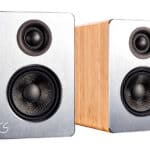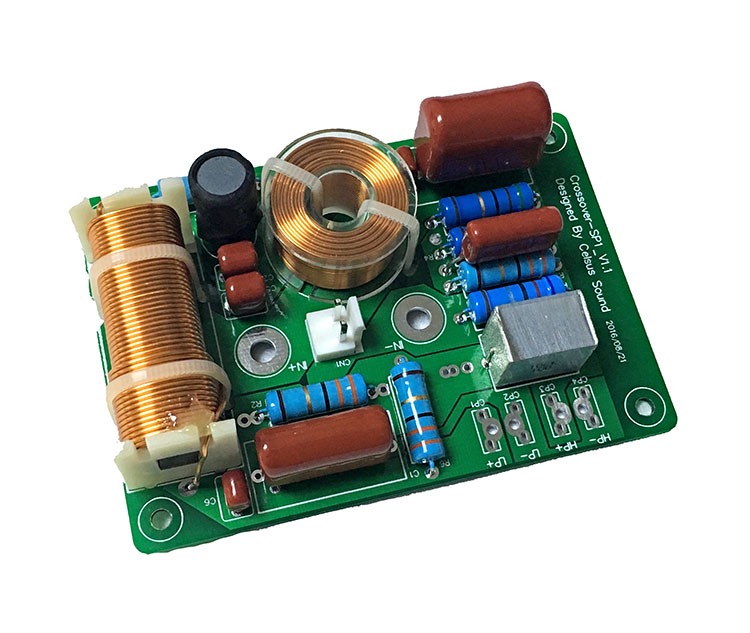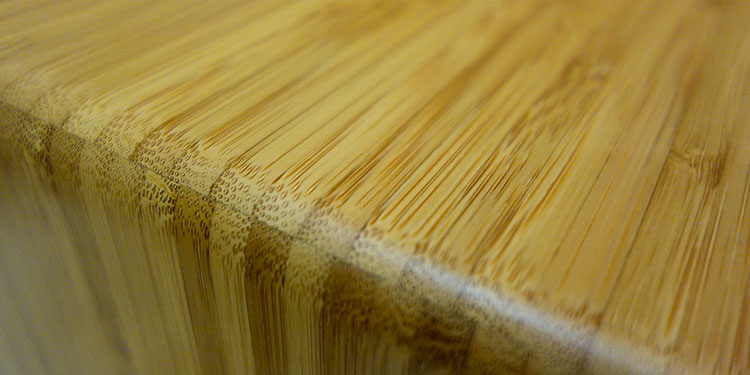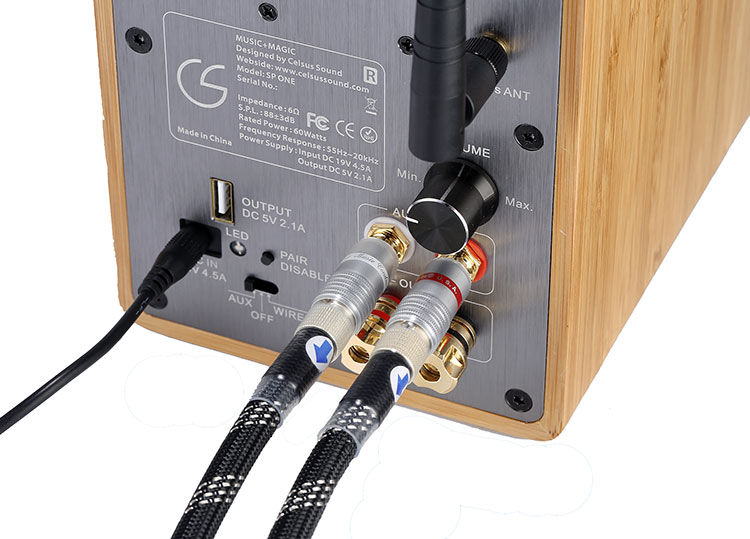In today’s review, we listen to the Celsus Sound SP One which is a bamboo-finished near-field Active Speaker with a warm midrange signature. They are priced at $649.
Disclaimer: This sample was sent to us in exchange for our honest opinion. Headfonics is an independent website with no affiliate links or status. Many thanks to Celsus Sound for giving us this opportunity.
To read more about Speaker products featured on Headfonics click here.
Note, that this article follows our latest scoring guidelines which you can read up on here.
I used to be a speaker guy about 20 years ago and went through the same GAS-induced ritual many of us did back in the day to keep up with the advent of CD, DVD than Blu-Ray.
I stopped at 5.1 before converting back to 2.1 and headphones. Before moving countries, I had to kiss goodbye to a B&W Series 2 system to a rather lovely Polish audiophile couple who took it, cables, desk, and all. They seemed happy.
I never got around to replacing it, blame that on a certain Little Dot MK2 tube amp and a spare set of Grado SR80’s and the birth of our son. Collateral damage and noise kept to a relative minimum for many a year since and quite happily so.
Yet, by 2012 back came a small set of desktop active speakers, a pair of D1010MKII 08’s from Swann, and right away I knew I was missing a piece in the audio jigsaw. A good pair of speakers is hard to replicate with headphones; they are sometimes two very different beasts for different occasions and moods.
Yet the Swann’s were a touch overkill for the cramped office so when Celsus Sound suggested I take their new SP One active speakers for a spin as an alternative for smaller rooms (and a possible upgrade) I was intrigued.
This is a $649 active bookshelf speaker. A price on par with some of the B&W bookshelf speakers I had enjoyed so much 15 years ago.
What Is The Pitch?
Connectivity
The SP One is a single woofer, single tweeter small active bookshelf speaker rated at 60W into 6 ohms that ships in passive, or active configurations and also includes wireless connectivity via Bluetooth.
It is primarily targeted to desktop 2.1 audiophiles looking for a tangible upgrade on a budget or mid-fi wired speaker system but want to retain a degree of flexibility by being able to stream their music from other sources such as DAP’s, smartphones or media centers.
Near Field
At $649 the SP One is a serious pitch at hi-fi enthusiasts as well as modern consumer needs. Most importantly, for those integrating with computer-based audio, Celsus Sound claims that the SP One is a quality near field performer, even on a low audible level.
I pick up on this point because the majority of computer audiophiles will likely be using the SP One in a near field configuration so it is vitally important, even with a mild inswing of the cabinets, that the speakers image clearly and in my case with particular emphasis on a natural-sounding midrange tone.
That is not to say Celsus does not feel that the SP One can’t fill a room, indeed they quite proudly claim this is not an issue, more of a personal preference on my side.
Carbon Fiber
Another key driver for the SP One is using carbon fiber rather than traditional paper or Kevlar cones for its woofers. Carbon fiber is traditionally quite expensive and does require a fairly complex crossover at the very top of the range due to their rigidity sometimes causing uneven transitions.
At the same time, carbon fiber is known to produce superior bass and mid-bass response compared to their paper equivalents. I have seen the word “tactile” used in some commentaries when it comes to Carbon Fiber woofers.
Celsus SP One Design
Dimensions & Materials
The build quality on the SP One is exceptional yet discreet. This is a double cavity cabinet design crafted from solid bamboo rather than some MDF/Bamboo veneer or the usual hardwoods some more expensive speakers use it looks incredibly natural and smooth rather than angular and gaudy.
There is nothing hollow sounding when knocked and it lacks any tacky seal joints or exposed screws to the front and sides. The corners are curved or fall away rather than angular, making it hand-friendly.
The SP Ones weigh in at 2.3kg and measure 195mm X 130mm X 180mm so whilst fairly low profile they are not lightweight either which is reassuring for issues such as vibration or inadvertent feedback loops (paperweights in computer stores).
Front
The front panel of the SP One enclosures is designed and finished with a smooth gray anodized aluminum front panel and houses a 3.5″ carbon fiber woofer and a 1.5″ soft dome, horn-loaded tweeter. Again, it’s a very discreet and simple design with no grills, dome wire cages, screws, or protective elements in front.
Clearly, the design aesthetic was critical in this aspect but it will risk the possibility of inadvertent damage on the domes so the emphasis here is to not place them in an area with high activity such as kids, pets or similar fast-moving “projectiles” even if the tweeter membrane is quite durable to the touch.
Always a debatable subject as I know quite a few who prefer grills off then on and swear the sound is better without. Ultimately it depends on the speaker and the grill materials.
Certainly, with my old B&W series 2 fronts I had grills off and only put them back on when we had a few people in the living area eating and moving around.
Rear
Features
As with most active speakers, the rear of the SP One is quite busy looking. Apart from the DC input to the far left you also have a DC 5v USB output socket, wireless/Aux on/off switch, a wireless reset and pair button.
These use a single set of speaker binding posts to carry the active signal from right to left and a set of RCA unbalanced input sockets for interfacing with your source of choice, for example, DAC analog outputs or a DAP line out to dual RCA. Volume is controlled by a large black analog potentiometer just above the dual RCA.
Wireless/Left
Finally, just below the bass port, you have the wireless antenna socket which does add a small amount of additional length to the SP One right speaker when screwed it as it is bi-directional with a short stalk and hinge mechanism. The left speaker is flush apart from the bass port and a set of left-right speaker binding posts.
Gold Plated
Just as a note the binding posts and dual RCA are gold plated with the posts themselves compatible with banana plugs. Personally, I used banana plugs over inserting the wires directing into the screw-down post. They are much more convenient to use and do a better job of preventing corrosion than bare wire, particularly in these humid climes.
The Feet
The only caveat I have with the SP One build quality are the sticky feet they come packed with. As of the time of writing they are rubber stick-on dimples and of slightly uneven quality meaning the SP Ones had a tough time getting set on my table.
I cured this by swapping them out for thicker grooved pads and inserting them in similar patterns to the base of the speaker. I believe Celsus One has acknowledged that the current pads are not stable enough so your newer editions will have thicker and softer silicone versions.
Features & Functionality
Wireless
Whilst the SP One can come in slightly cheaper if you choose the passive model ($499) but it is the active model that has the Bluetooth wireless functionality.
The SP One Active is fully up to speed on BT tech also with a 4.0 Bluetooth transmitter and receiver module with aptX technology meaning you should be able to get a better extension to your distance from the source as well as a better grade of signal and slightly less compressed one at that.
In short, it should not sound murky and lacking in dynamics.
Wired
The wired analog signal is received via a traditional dual RCA input from either a preamp or DAC (or hybrid) unbalanced output. The active circuit is housed in the right signal and is connected to the left passive speaker via the speaker bindings posts and a set of short speaker cables that come with the SP Ones.
Performance
It can handle up to 60w into 6 ohms also if you are pre-amping with an average sensitivity rating of 88dB which places it in the typical median range of speaker efficiency ratings. Sitting in a near field configuration they shouldn’t require anything more than 1 – 2 watt (2.8v) in their passive configuration.
Technically my setup is a touch close to some concrete walls in a near field configuration so my dispersion loss is going to be quite low and my dB gain from placement a touch higher.
S,o I won’t need anywhere near the level of power the active amp can offer however my guess is the max room space on these speakers is about 20 feet (avoiding cornering) before they start to tap out.
Celsus SP One Sound Impressions
Summary
The SP Ones have a very natural and balanced tonal presentation with excellent near field performance. Micro detail, particularly midrange instrumental clarity is organic and spacious sounding.
The timbre on the SP Ones is very smooth, much more so than my previous set, the Swann’s which tended to throw a much more lively sound but at the cost of some midrange coherence.
The top end is more chilled than forward but again the detail is excellent, particularly at low listening levels and there is plenty of headroom in its tweeter response so I never felt it unnaturally shelved down.
If anything, mids are slightly enhanced with a more forward vocal range than lower mids but only slightly. There is just enough to gain an audible pleasure on vocal tracks, particularly on movie dialogs, in which some center speakers or larger 2.1 setups struggle to elevate beyond the background noise.
Bass
One thing you cannot accuse the SP One of having is lean low-end performance. Midbass response is mildly elevated with a warm sheen to it but it in no way bloated or soft sounding.
As with most bookshelf speakers, there is not too much sub-bass reach with it falling off pretty quick beyond 60Hz (HPF?). If you want serious sub-bass, like any speaker configuration, I suggest buying a subwoofer to complement the SP Ones.
Having said that the SP One mid-bass is more than snappy with decent weight and body and kicks up a very inviting musical signature particularly with EDM and rock.
If you are positioning near-field I would advise though to not place them close to any wall to prevent any unwanted boom on the SP One low end. The tuning on these is just right with the bass port given space to breathe.
Mids
There is a small dip also just as you cross over into the midrange spanning from 300Hz to 500Hz max keeping instrumental low end clean and clear as well avoiding upper bass bloat and bleed. Mids and upper mids have a mild yet smooth elevation with a slight emphasis on vocal performance.
Male vocals, in particular, sitting dead center around 1k, have excellent texture and body whilst slightly higher-pitched female vocals are more rounded and pleasing with a slightly softer attack.
Celsus Sound has gone for a more organic and smooth flowing timbre with the SP One. You won’t find any sharp attacks or lingering delays and that softer approach also avoids any problems with sibilance creeping in.
Those after a lean Tannoy sound or the cooler B&W clarity might find the SP One lacks a touch of midrange bite, but for me running these near-field I think they are right on the money between natural and musical.
Treble
Treble on the SP One is a smooth and relaxed presentation with minor tilts northwards around 5-7k and again at 13-14k for that typical hi-fi touch of clarity and sparkle as well as offering decent headroom.
It not the airiest of speaker configurations but it is clear and articulate with very little in the way of harsh peaks and dips. It’s coherent sounding and in keeping with the rest of the FR’s tonal quality.
Synergy
Wireless
Lock-On
The wireless performance of the SP One will depend on both the BT source as well as your room configuration. What I can say that the SP One lock-on for BT signal is excellent even down to AD2P BT3.0. Apt-X capable and regular non-aptX BT 4.09 devices will perform at roughly the same distance and similar barriers in the line of sight between the source and SP Ones.
A simple FiiO X1 2G BT 4.0 connection acquired a lock on around 15ft away with one wall divider which was the exact same distance as an aptX capable AK380 and my own BT4.0 ZTE Axon 7 smartphone.
The same also for the older AK120 Mk1 with its AD2P BT3.0 module which traditionally has never given me the same level of range as more modern aptX capable modules.
Tonality
Tonally, though the quality of the connection and the technology in use will make a fairly substantial difference. You can get admirable and listenable playback with the AK120 MK1 AD2P module but it sounds relatively compressed and lacking in dynamics compared FiiO and ZTE’s BT4.0 implementation.
They both sound slightly less resolving than the AK380’s apt-X capable module. It is not quite as vivid and engaging as going fully wired but it is pretty competitive with aptX.
Playback Control
One cool little thing is the two-way communication of the SP One which I am not sure is explained in the manual and not applicable to all devices. At the back of the SP One is the pair and reset button which you simply press and hold down to start the pairing process with a flickering purple LED.
It is a simple process and all devices I used (4 in total) locked onto the signal and gave accurate feedback right away. However, for the ZTE and AK380, a quick press actually paused the music and another press started the music again.
This didn’t happen on the FiiO X1 2G which also has Bt4.0 but otherwise, it is a pretty small but cool feature on the SP One.
Wired
Wired is always preferred over wireless for optimal sound but one thing I noted with the SP One is the level of coloration different DAC’s brought when hooked up. It seems fairly responsive to the source sound.
Warmer sounding DACs with lively low ends such as the dual WM8741 uDAC-2496 from Just Audio transformed the SP One into a more planted low-end colored set of speakers.
I got a fairly lively sound but I felt the low end increased response upset that nice tonal balance I got with more neutral DAC’s such as the Essence HDACC (ES9012).
Somewhere in between sat the line out of the Continental Dual Mono which produced a more balanced sound with the SP One than the Just Audio matchbox DAC but at the slight cost of top-end clarity.
ESS DAC’s such as the NuPrime DAC-10, Chord Hugo, and Essence HDACC brought out the detail and dynamic performance that suited my nearfield set up the best, particularly at lower volumes.
The Hugo probably had the most neutral of all 3 performance-wise but my personal preference was the Essence HDACC which sounded just a little more natural with a smoother top end.
Our Verdict
Overall I am quite impressed with the SP One performance and value-add features as a desktop active set of speakers. The tonal quality is smooth, inviting, and very balanced with those carbon fiber 3.5″ woofers punching way above what I expected for their size.
They are not bass monsters and have a solid eye for detail and a slightly elevated midrange and vocal performance which is a plus for anyone wanting a near-field configuration. They do go loud enough also to fill a mid-sized room but watch for unintended reflections, i.e. do not corner them as the resulting bass boost is not ideal.
The build quality is excellent, the weight is just right, and their low profile dimensions make them fairly unobtrusive guests on any standard computer table of reasonable size. With the new silicone feet coming out they should also balance better than the initial rubber stick-on feet.
Value adds such as using BT (wireless) does free them from the desk should you wish to space them further apart than the standard supplied speaker cable will allow but be aware that aptX is the only advisable connection I would recommend to get anywhere near the clarity and dynamics wired can offer.
Celsus Sound SP One Specifications
- Frequency Response:55Hz to 22kHz
- Impedance: 6 Ohms
- Power Rating: 60W
- Sensitivity: 88db
- Inputs: Bluetooth & Line In
- Power Supply: AC adapter (DC19.5V, 3.16A)
- USB Port 5V DC charging Port for external accessory
- Dimensions (H x W x D): 195mm X 130mm X 180mm
- Weight: 2.3Kg







